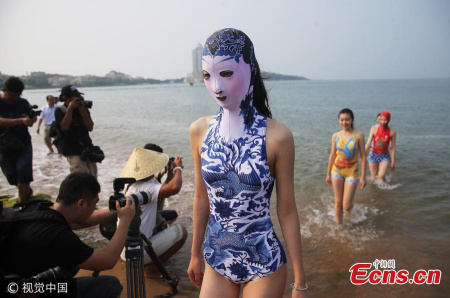
Models show a new version of the face-kini in Qingdao City, East China’s Shandong Province, June 28, 2017. The 7.0 version, according to its designer, features blue-and-white porcelain and embroidery, while in the past it has also featured Peking Opera and endangered animals. The face-kini mask is designed for swimmers and beachgoers to cover the head and reveals only the eyes, nose, and mouth of wearers to protect them from suntan, jellyfish and other irritants. It started in Qingdao and became popular among beachgoers in other coastal areas. (Photo/VCG)
Qingdao's signature swimwear product attracts more and more Chinese and overseas beachgoers in niche market
The facekini, an emerging favorite among Chinese beachgoers and hot topic in social networking circles, has once again attracted the public's attention after the release of the latest generation which debuted on June 28 in Qingdao. Driven by high demand, its famous, unique appearance and practical function of sunray protection, the facekini has become a robustly growing niche segment within the overall swimwear market as China's consumption upgrades unleash more business potential for ambitious entrepreneurs.
Zhang Shifan, the 61-year-old facekini inventor who resides in Qingdao, East China's Shandong Province, has witnessed her products gradually going international over the past decade ever since she invented the highly demanded product.
Originating from Qingdao, the beachgoer face mask, also known as "the facekini" in the West, has attracted many headlines, both domestically and abroad, due to its unique appearance.
The facekini craze is sweeping across China's beaches as consumers view it as the most effective and practical way to avoid the damaging effects of sun exposure, a purpose also pointed out in media reports.
The nylon-made product has become a hot topic within Western media reports, particularly since Reuters posted photos of middle-aged women wearing them on the beaches of Qingdao in 2012.
A Qingdao resident, surnamed Jia, bought five facekinis online for her family last year and bought two more this year.
"I find wearing the facekini comfortable due to its high elasticity and effective protection from the sun,'' Jia, who regularly visits the beach during summertime, told the Global Times on Monday.
A new trend
Last July, Li Yang, a Beijing-based white-collar worker, tried out a facekini for the first time, and found that it was indeed crucial when playing water activities in the sun during a visit to Bali, Indonesia.
"At first, I was shocked by my appearance while wearing it, but then I got used to it and realized that protecting my face from the sun was more important than the way I look," Li told the Global Times Monday.
The facekini is not only popular among domestic consumers, it is also becoming increasingly popular overseas.
The facekini can be found in Australia as well as some Southeast Asian countries, Zhang told the Global Times on Thursday, noting that "about 30,000 to 40,000 facekinis were sold both online and offline last year."
When Zhang first invented the facekini in 2004, she never foresaw its current popularity.
The invention of the facekini aimed to be an addition to the anti-jellyfish swimming suit, which was also invented by Zhang.


















































